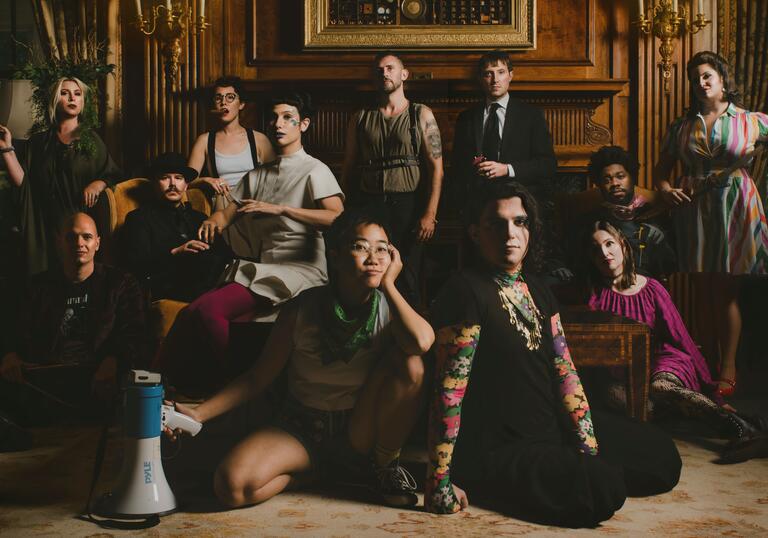
Programme and performers
Caroline Shaw The Isle
Leilehua Lanzilotti On Stochastic Wave Behavior (European premiere)
Angélica Negrón math, the one which is sweet
Alev Lenz 7 planets (world premiere)
1. Mercury
2. Venus
3. Mars
4. Jupiter
5. Saturn
6. Uranus
7. Neptune
Roomful of Teeth
Estelí Gomez
Mingjia Chen
Caroline Shaw
Virginia Kelsey
Jodie Landau
Steven Bradshaw
Thomas McCargar
Cameron Beauchamp director
Song texts
Ariel
Come unto these yellow sands,
And then take hands:
Curtsied when you have, and kissed
The wild waves whist,
Foot it featly here, and there, and sweet sprites bear
the burden.
[Burden dispersedly, within]
Hark, hark, bow wow: the watchdogs bark, bow wow.
[Burden dispersedly, within]
Hark, hark, I hear, the strain of strutting Chanticleer
Cry cock-a-diddle-dow.
Full fathom five thy father lies,
Of his bones are coral made:
Those are pearls that were his eyes,
Nothing of him that doth fade,
But doth suffer a sea change
Into something rich and strange:
Sea nymphs hourly ring his knell.
[Burden: ding dong.]
Hark now I hear them, ding dong bell.
Caliban
Be not afeard. The isle is full of noises,
Sounds and sweet airs that give delight and hurt not.
Sometimes a thousand twangling instruments
Will hum about mine ears, and sometimes voices
That, if I then had waked after long sleep,
Will make me sleep again; and then, in dreaming,
The clouds methought would open, and show riches
Ready to drop upon me, that when I waked
I cried to dream again.
Prospero
You elves of hills, brooks, standing lakes, and groves,
And you that on the sands with printless foot
Do chase the ebbing Neptune, and do fly him
When he comes back; you demi-puppets that
By moonshine do the green sour ringlets make,
Whereof the ewe not bites; and you whose pastime
Is to make midnight mushrumps, that rejoice
To hear the solemn curfew; by whose aid,
Weak masters though you be, I have bedimmed
The noontide sun, called forth the mutinous winds,
And ‘twixt the green sea and the azured vault
Set roaring war; to the dread rattling thunder
Have I given fire, and rifted Jove’s stout oak
With his own bolt; the strong-based promontory
Have I made shake, and by the spurs plucked up
The pine and cedar; graves at my command
Have waked their sleepers, oped, and let ‘em forth
By my so potent art. But this rough magic
I here abjure, and when I have required
Some heavenly music, which even now I do,
To work mine end upon their senses that
This airy charm is for, I’ll break my staff,
Bury it certain fathoms in the earth,
And deeper than did ever plummet sound
I’ll drown my book.
(Solemn music)
Roomful of Teeth
Roomful of Teeth is a Grammy Award-winning vocal band dedicated to reimagining the expressive potential of the human voice. By engaging collaboratively with artists, thinkers and community leaders from around the world, the group seeks to uplift and amplify voices old and new while creating and performing meaningful and adventurous music using a continuously expanding vocabulary of singing techniques.
Roomful of Teeth has built a significant and ever-growing catalogue of music through collaboration with a broad range of composers, including Julia Wolfe, David Lang, Missy Mazzoli, William Brittelle, Angélica Negrón, inti figgis-vizueta, Paola Prestini, Nathalie Joachim, Caroline Shaw, Leilehua Lanzilotti, Anna Clyne, Sarah Kirkland Snider, Cava Menzies, Judd Greenstein, Terry Riley, Toby Twining, Ted Hearne, Eve Beglarian, Caleb Burhans, Ambrose Akinmusire, Michael Harrison, Peter S Shin and Jerod Impichchaachaaha’ Tate.
Recent appearances include performances at Carnegie Hall, Lincoln Center, Kennedy Center, Walt Disney Concert Hall and Kings Place in London. The group has also performed specially commissioned works with the Los Angeles and New York Philharmonic, BBC, Cincinnati and Seattle Symphony orchestras and Cabrillo Festival Orchestra, among others, and collaborated with opera director Peter Sellars in Claude Vivier’s Kopernikus.
Roomful of Teeth’s discography includes its eponymous first album, released in 2012, which won a Grammy Award. Other recordings include Render (2015), The Colorado (2016) and Yo-Yo Ma’s Silkroad Ensemble’s album Sing Me Home, which won a Grammy in 2016. The group also has released two EPs: The Ascendant (Wally Gunn) and Just Constellations (Michael Harrison). Its newest album, Rough Magic, was release in May to great critical acclaim. Roomful of Teeth’s recordings have been featured on television and in film, including Josephine Decker’s Madeline’s Madeline, Netflix’s Dark, Jeen-Yuhs: A Kanye Trilogy and Homecoming: A Film by Beyoncé.
Visit www.roomfulofteeth.org to learn more and to support the group’s work.
